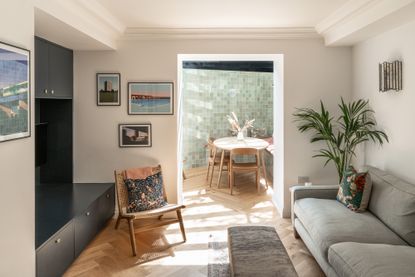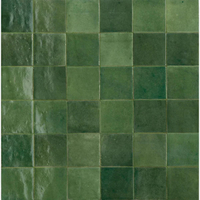It's unconventional! This centuries-old trick for making small rooms feel bigger is having a revival
It might feel a little unusual, but this wall covering choice can make magic in tiny spaces, according to an architect


Did you know that the onset of Seasonal Affective Disorder is thought to peak in November? It's possibly not a surprise that this month has the most cases of this form of seasonal depression - after all, in many parts of the Northern hemisphere, it means dark mornings, dark evenings and flat grey days. The good news is, then, that we're almost out the other side, but that doesn't necessarily mean we're going to see an end to the sort of dull weather that saps the energy from our homes.
In searching for a solution for the darkest, dreariest rooms in my own small home that suffer the worst at this time of year, I came across an unconventional idea for a wallcovering that promises to transform how a room feels on days with even the most uninspiring weather outside.
It's an interior design trend that, I believe, is on the rise, and thankfully, it can look particularly stylish and design-forward. The big question is: are you ready to tile your living room walls?
What can tiled walls do for a small space?

You'll commonly see whole tiled walls in bathrooms and kitchens, but less so in rooms like bedrooms, living rooms and dining rooms – yet, for architect Matthew Wood, founder of London-based MW Architects, it's a signature design he implements to make small, dark rooms feel brighter that he says is based on a 'Victorian technique for reflecting light down internal courtyards.'
'Glazed tiles are partially reflective which of course helps bounce light,' he tells us. But it's not just as simple as putting any old tile on the walls. Texture is equally important in making this idea so successful in his designs. 'As well as interest, light on texture creates the effect of depth that increases the sense of space.'
This means using something like a Zellige tile – a handmade tile that tends to produce an uneven surface through non-standardized thicknesses and has natural color variation.

As well as the dark green-tiled small living room above, Matthew has also implemented the idea in this small dining room which, despite having a slim-lined glazed roof, is on the lower ground floor of this home. This means it's flanked by tall buildings that can block natural light from entering at certain times of the day.
Regardless, the architect looked to this wall covering idea to make the very most of the light available to it, no matter what time of day. 'The walls had to have texture for the light to wash over,' he tells us. 'This creates a dynamic effect of changing light and reflection.'
You can see the appeal. Where on a dull day, white walls can feel grey-washed and lifeless, these walls retain a depth and sheen regardless that ensures that they never feel flat.

However, this isn't the only way in which this design functions to help this home's small, dark spaces feel brighter and happier. It provides a sightline from the even darker living room adjoining it, designed in a way to make the space feel like a 'glade' that the existing darker rooms focus on.
'Pools of light in a natural environment such as in a forest glade help to punctuate space,' Matthew explains. 'It is a focal point and a natural draw where the connection to the sky and the sun can be fully experienced.'
For a room that has no sightlines to green spaces, a key Biophilic design idea for calming, joyful spaces, the design of this room creates its own kind of nature. 'As the scheme developed and the materials were being curated the variance in the green Zellige tiles felt more and more like dappled light through leaves and the glade concept grew, tying the last few elements of furniture, light fittings and soft furnishings together.'
How much do Zellige tiles cost?
Zellige tiles tend not to be cheap, largely down to the processes used to make them and their appeal for luxury homes, which can make this small space idea a little more challenging. Generally, Zellige tiles can range between $50-$100 per 6 square feet. However, there are some cheaper 'Zellige-style' porcelain tiles on the market, which can be used to recreate the effect.
It's also the sort of idea that lends itself well to an accent wall, following Matthew's advice in choosing a wall that has an interaction with the natural light your room does get.

Ceramic Zellige tiles, Home Depot
These Zellige tiles from Home Depot aren't necessarily cheap, but at $54 per 5.81 square foot, they're cheaper than many Zellige tiles on the market.
Be The First To Know
The Livingetc newsletter is your shortcut to the now and the next in home design. Subscribe today to receive a stunning free 200-page book of the best homes from around the world.

Hugh is the Editor of Livingetc.com. From working on a number of home, design and property publications and websites, including Grand Designs, ICON and specialist kitchen and bathroom magazines, Hugh has developed a passion for modern architecture, impactful interiors and green homes. Whether moonlighting as an interior decorator for private clients or renovating the Victorian terrace in Essex where he lives (DIYing as much of the work as possible), you’ll find that Hugh has an overarching fondness for luxurious minimalism, abstract shapes and all things beige. He’s just finished a kitchen and garden renovation, and has eyes set on a bathroom makeover for 2024.
-
 What are the Most Comfortable Pillowcases? From Temperature Regulating to the Best for Your Skin
What are the Most Comfortable Pillowcases? From Temperature Regulating to the Best for Your SkinWhen you're looking for comfort in your pillowcases, material matters. These are the best you can buy
By Faaizah Shah Published
-
 5 Simple, but Genius Bathroom Layout Tricks That Will Make Your Space Work so Much Harder
5 Simple, but Genius Bathroom Layout Tricks That Will Make Your Space Work so Much HarderSmall switches to how you lay out your bathroom that help make the most of a small space
By Luke Arthur Wells Published

